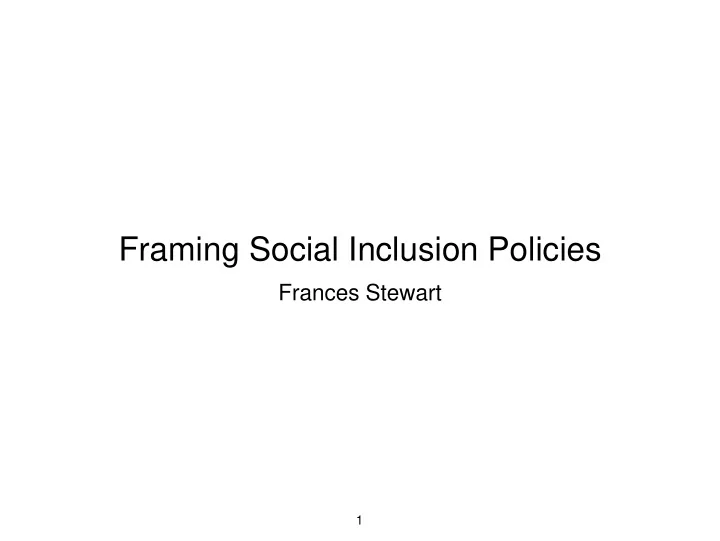

Framing Social Inclusion Policies Frances Stewart 1
Presentation • What is social exclusion • Approaches to framing SI policies • Types of policy 2
Defining Social Exclusion (SE) • “exclusion is a concept that defies clear definition and measurement”.(Mickelwright). • First advanced for developed countries - multiple aspects of marginalization and deprivation. Aspect of EU policy. • Defined by EU as a: “process through which individuals or groups are wholly or partially excluded from full participation in the society in which they live” (similar to Townsend on poverty). 3
Other definitions 1. Atkinson: relativity; agency; dynamics. 2. Room: multidimensionality; neighbourhood aspects - lack of communal facilities; discontinuities. 3. Peace, summary: “Social exclusion is a set of processes, including within the labour market and the welfare system, by which individuals, households, communities or even whole social groups are pushed towards or kept to the margins of society. It encompasses not only material deprivation but also more broadly the denial of opportunities to participate fully in social and civil life ” 4
IN SUMMARY, CHARACTERISTICS OF SE ARE : • RELATIVE TO ‘NORMAL’ • MULTIDIMENSIONAL • A PROCESS • OFTEN A GROUP CHARACTERISTIC • RELATIONAL • Characteristics depend on society 5
How to apply to developing countries? • Deprivation is ‘normal’ • Yet helpful concept because of focus on process of deprivation and structural characteristics of society. • But interpretation arbitrary and varies: 1. take norms from elsewhere : e.g. India, not having access to certain modern services; Venezuela, not having certain social and political rights. 2. consultation/participatory process (in Tunisia, led to def. of SI as having employment and guaranteed income; in India, revealed none as SE, some as socially expelled) 3. identify certain excluded groups , through prior knowledge and assumption.Most common— Tanzania, poor urban occupations and rural landless; Cameroon and Thailand, minorities; S. Africa, marginal working class and jobless. 6
2. Framing policy for SI. First define and identify excluded. A pragmatic approach Socio-economic perspective , • In relative poverty – e.g. bottom 20 or 40% in monetary/multidimensional poverty; • Lack ‘decent jobs’, using ILO definition. • Lack a minimum set of basic services – including education, health services, access to clean water and sanitation. • Those without shelter. Political perspective , • Those without citizenship; • Those whose group (ethnic/caste/racial/religious) has little or no representation in the political organs, especially at higher levels. Cultural perspective , • Those whose language is not used in education or government; • Religious rights not respected; • Dress, diet or other aspects of culture are constrained or banned. 7
3. Types of policy a. correcting deep structural causes • land reform; • wealth redistribution; • reforming caste system; • changing mode of production. • Some can be done; but mostly only in revolutionary situation. 8
Types of policy. b. incremental corrective policies • Types of policy: • 1. Direct and indirect. • 2. Predistribution and redistribution. • Note: depends on who is deprived and dimension of deprivation; and causality among dimensions to identify priorities. 9
Direct and indirect policies Direct policies target policies directly to the deprived groups. EG. positive discrimination. Or means tested benefits. Errors of omission may be high. — can be effective, but may arouse hostility. Direct policies particularly appropriate when (i) visibility of effort is needed, as after a conflict; (ii)the deprived group is well defined; (iii)the SE group is small relative to whole population. 10
Indirect policies Indirect policies -universal policies, applicable to whole population, designed to contribute to reducing SE. EG., a guarantee of full employment, or universal health services or universal citizenship for all residents. Anti-discrimination laws, and progressive taxation. Less likely to leave some deprived out. ? more politically acceptable. Not always effective and may take time, or fail, to reach the most excluded. EG. the disabled — most of the universal policies might not reach them, if they lack the capability to make use of them.
Predistribution and redistribution • Predistribution policies affect distribution when accrued/earned. EG minimum or maximum wage; limits on bonuses; strengthening trade unions to improve wages; competition laws; education policies. (And most structural policies). • Redistribution policies change distribution after primary earnings: by taxation and expenditure. Well known policies - progressive taxation; higher levels of taxation and expenditure. focus on social service expenditures and primary services. 12
Predistribution varies greatly; and Redistributive policies have big impact 13
Beyond socio-economics • Need to address political and cultural exclusion. • Both direct and indirect policies relevant. • Direct: reserved political positions; support for particular languages. • Indirect: universal franchise, proportional representation, decentralisation; banning discrimination in relation to religion, or culture. 14
: Examples of policies for different dimensions of SI Dimension of exclusion Direct Indirect Voting system; Group quotas; seat reservations; human rights Political consociational constitution; ‘list’ PR legislation and enforcement Anti-discrimination legislation; progressive taxation; Quotas for employment or education; regional Socioeconomic special investment or credit development programmes for particular groups programmes; universal education/health etc Minority language Freedom of recognition/education; symbolic religious Cultural status recognition in public holidays, at state observance; functions no state religion Source: adapted from (Stewart 2008): 304. 15
Beyond laws • Social institutions - norms - critical. • Much exclusion results from informal interactions: For example, a UK Muslim girl aged nine: • ‘I’m getting bullied at school. People in the neighbourhood are calling my family “terrorists” and say, “Go back to your own country.” I’m worried they’ll start saying these things at school. Muslim boys are getting beaten up at school.’ • Tackling social discrimination is another critical, but extremely complex, aspect of SI, involves education, leadership… 16
• Thank you • Frances Stewart (@Some0172)
Recommend
More recommend